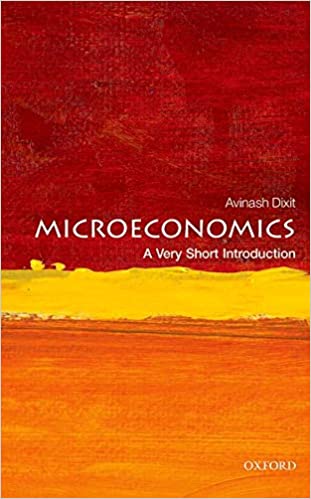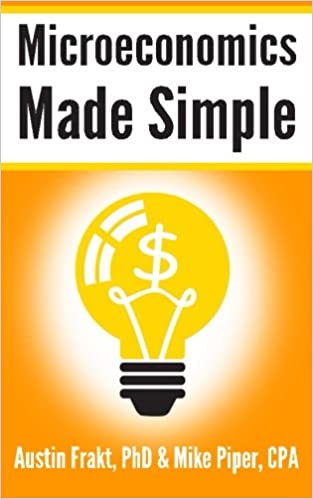Books on Microeconomics: A Reading List
13 books that will get you up to speed with Microeconomics
The study of Microeconomics will help you understand how individuals, households and industrial sectors function within the economy. It does this by using the Laws of Demand and Supply. The setting of price based on demand and supply by these entities is covered under the Price Theory.
Microeconomics studies consumer behaviour and producer behaviour under Consumer theory and Producer theory respectively. It analyses the interaction between the two in the economic market and how they arrive at an equilibrium that satisfies both parties.
Microeconomics is used to understand the behaviour of these units and thereby develop policies that have maximum productive potential that reaches out to the widest group. Microeconomics is the tool that economists use to explain trade equilibrium, exchange rate determination and Balance of Payments positions.
Microeconomist experts work at testing and honing microeconomic models to suit the changing markets. The first books on Microeconomics were penned by Alfred Marshall and Léon Walras in their books Elements of Pure Economics and Principles of Economics respectively. It is worthwhile to read these two great masters to understand the origin and fundamentals of Microeconomic theory.
Elements of Pure Economics by Léon Walras
Walras assumes conditions of free competition before he showcases how factors of production, prices and products will strive for equilibrium. This book covers objects and divisions of political and social economy, exchange of commodities for each other, capital formation and credit, circulation of money, price fixing, monopoly and taxation, geometrical theory of determination of prices and the theory of production. Walras is credited with introducing mathematical models and perspective into Economics as can clearly be evinced in this volume. Get the Book - Elements of Pure Economics by Léon Walras
Principles of Economics by Alfred Marshall

Published in 1890, Principles of Economics is the finished volume 1 of two volumes. Marshall explores the interplay of demand and supply to arrive at a price. In his preface he states that he does not focus only on economic laws but on ethics as well.
This volume is divided into 5 books. Book one is a preliminary survey of Economic Laws. Book two deals with the fundamental notions of wealth, production, consumption, income and capital. In book 3 the author covers the satisfaction of wants in which the Elasticity of demand, value and utility are areas of study.
In book 4, the agents of production are discussed in-depth. The factors that influence land, population, wealth and labour are elaborated on.Book 5 is titled The General Relations of Demand. The key chapters in this book are equilibrium of normal demand and supply, joint and composite demand, marginal costs, the doctrine of maximum satisfaction and the theory of monopolies.
Principles of Economics is a seminal work that has help train economists and thereby influence microeconomic theory. Get the Book - Principles of Economics by Alfred Marshall
Microeconomics by Paul Kraugman and Robin Wells

Nobel Laureate Paul Kraugman collaborates with writer Robin Wells to bring out a useful and informative book on Microeconomics. It touches on all the important concepts in Microeconomics and is included with case studies and several real-world examples. The book has a story-like narrative with theory and events woven together aptly. The text is split into 9 main areas; What is Economics, Supply and Demand, Individuals and Markets, Economics and Decision making, the Consumer, the Production Decision, Market structure beyond Perfect Competition, Microeconomics and Public Policy and finally Factor Markets and Risk. Get the Book - Microeconomics by Paul Kraugman and Robin Wells
Principles of Microeconomics, 7th edition, by N.Gregory Mankiw

This comprehensive book on Microeconomics scores high with readers who might be beginning to read microeconomics or are conversant with it. Author Gregory Mankiw teaches at Harvard both micro and macroeconomics. The writing is not intimidating and this makes it an enjoyable text. The Principles of Economics, Thinking like an Economist and Interdependence and the Gains from Trade constitute the Introductory chapters. The book then moves on to How Markets Work, Markets and Welfare, The Economics of the Public Sector, Firm Behaviour and the Organization of Industry and The Economics of the Labour Markets. Get the Book - Principles of Microeconomics, 7th edition, by N.Gregory Mankiw
Principles of Microeconomics 2E by Steven.A.Greenlaw

What is economics, Supply and Demand, The Fundamentals of Microeconomic theory, Microeconomic Policy Issues and International economics form the five parts this book is split into. The book uses case studies, economic data (mostly from Federal Reserve Economic Database), tables, graphs and in-depth analysis for the readers to understand the scope and importance of microeconomics.
This book uses 4 types of questions for students to check their subject knowledge. Self check questions for formative assessment, open-response review questions, higher order critical thinking questions to enable better contextual understanding and additional analytical and computational problems. This robust text is a good buy for Econ students. Get the Book - Principles of Microeconomics 2E by Steven.A.Greenlaw
Microeconomics (Perason series) by Robert Pindyck and Daniel Rubenfeld

The authors in their preface note elucidate that the book was written to incorporate game theory and competitive strategy, the roles of uncertainty and information, methods of pricing followed by firms with market power in microeconomics. Their intent is to enable students to use microeconomics as a practical tool for decision making.
The focus of the book in this context is more towards relevance and application in the spheres of public policy and managerial decision making.To this end examples on analysis of demand, cost, price strategies, public policy analysis, investment and production decisions are included.
We recommend this book because it's not a theory heavy text but one that makes microeconomics more relatable and emphasises its real world applications. Get the Book - Microeconomics (Perason series) by Robert Pindyck and Daniel Rubenfeld
Microeconomics by Austan Goolsbee, Steven Levitt and Chad Syverson

The authors refer to their book as the book of ' useful economics'. Real life case studies, figure it out exercises, make the grade essays (finer microeconomic theory and practical advice students can learn from when submitting essays), clear and direct writing, graphs, detailed algebra, geometry and calculus are used to help students use math as a microeconomic tool. The tone used is conversational and the algebra in the main text is connected with the calculus in the appendices through marginal notes in the chapters.
Some of the key topics are in the book are Adventures in Microeconomics, Supply and Demand, Using Supply and Demand to Analyze Markets, Consumer Behaviour, Producer Behaviour, Individual and Market Demand, Costs, Supply in a Competitive Market, Market Power and Monopoly, Game Theory, Factor Markets, Behavioural and Experimental Economics and Pricing Strategies for Firms with Market Power. Get the Book - Microeconomics by Austan Goolsbee, Steven Levitt and Chad Syverson
Microeconomics by Glen Hubbard and Anthony O'Brien

This book contains all the important concepts of Microeconomics, what is different though is the treatment the authors have given it. Real world examples are viewed through the lens of microeconomics. Two notable ones are the introduction of the iPod and the burst of the US housing bubble.
The book can be divided into these broad areas: Policy Issues, introduction to microeconomics, monopolistic competition, game theory, pricing strategy and the economics of information.
The book's special features are business cases, economics in your life, solved problems, don't let this happen to you (common mistakes students make in a concept), making the connection (using real life examples to connect theory with the real world), and graphs and summary tables. Get this Book - Microeconomics by Glen Hubbard and Anthony O'Brien
Microeconomics Made Simple
Absolute beginners can use Microeconomics Made Simple as a quick guide to the key concepts in microeconomics. This 134 page book is split into two main parts; Basic Economic Concepts and Firm Behaviour in Different Types of Markets. The author informs us that this book cannot be a replacement for a comprehensive text but serves more as a concise and quick introduction to microeconomics. Get this Book - Microeconomics Made Simple
Principles of Economics by Lee Coppcock and Dirk Mateer

The authors are professors at the University of Arizona and the University of Virginia. This text has been developed based on their experience with over 50,000 students. The questions asked over the years by the students have helped shape this book.
It has an easy narrative, using problem solving to develop economic decision making abilities and asking the big questions first. This book is a Covid-19 edition and therefore incorporates why people hoarded toilet paper and the impact of lower consumer income on AirBnb. The test bank includes economic articles written during the pandemic.
The fundamental microeconomic concepts and, explanations continue to be in place. Get this Book - Principles of Economics by Lee Coppcock and Dirk Mateer
Microeconomics: Public and Private Choice by James D. Gwartney, Richard.L.Stroup

This book is split into 5 parts, which are, The Economic Way of Thinking, Markets and Government, International Economics and Applying the Basics. The authors have delved into the impact of the Invisible Hand Metaphor and have use cases to make their point. Some interesting topics under Apply the Basics include earning differences between men and women, the economics of healthcare, difficult environmental cases and the role of the government and the question of resource exhaustion. Get this Book - Microeconomics: Public and Private Choice
Intermediate Microeconomics: A Modern Approach, 9th edition by Hal.H.Varian

The author's original intent in writing this text was to enable students to use microeconomics as an everyday tool, rather than as just theory. He has therefore stressed on the fundamentals of microeconomics concepts along with examples of application. He has been careful not to load the book with anecdotes and economic terminology. The author has included appendices on calculus.
The chapters have been kept to lecture size and a workbook with economic problems has been provided. Students of microeconomics may find that the book is not adhering to their curriculum but it is suggested for its wealth of real-world application. In that sense it is a valuable read for anyone who might want to understand microeconomics in-depth and from a modern perspective. Get this Book - Intermediate Microeconomics: A Modern Approach
Microeconomics, A Very Short Introduction by Avinash Dixit

This 152 page pamphlet book is considered one of the best books on microeconomics for beginners and veterans. The text has the following chapters; The what and why of microeconomics, Consumers, Producers, markets, Market and policy failures, Institutions and organisations and What works.The author writes in an easy to understand style, without compromising on the concepts. Get this Book - Microeconomics, A Very Short Introduction




